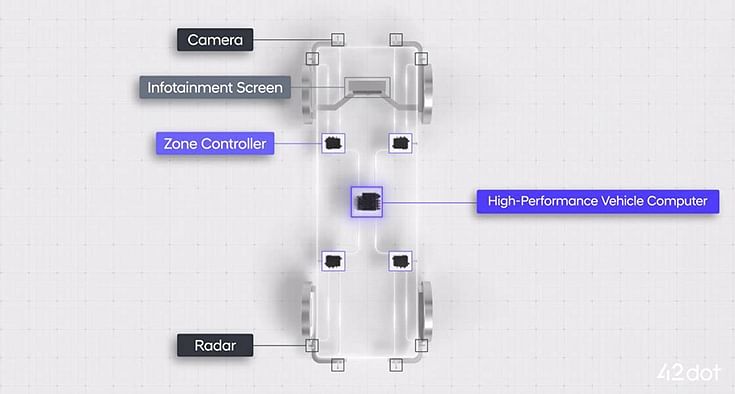Hyundai’s new global growth strategy banks on software-centric shift
Targets 5.55 million annual global sales including 2 million EVs by 2030, up 30% from 2023; aims to transition to a development system for software-defined vehicles by incorporating software development methods into vehicle development; SDV Pace Car equipped with high-performance vehicle computer electronics architecture currently under development.
On August 28, Korean automaker Hyundai Motor Co unveiled its new mid- to long-term strategy – the Hyundai Way – on August 28. The overarching goal is to enhance its electric vehicle (EV) and hybrid competitiveness, advance its battery and autonomous vehicle technologies, and expand its vision as an energy mobilizer, responding to the market environment flexibly with its dynamic capabilities.
While the first part of the ‘Hyundai Way’ is about expanding the hybrid line-up from seven to 14 models (including the Genesis brand), introducing new EREV models with 900km range as a key bridge to full electrification, a full EV line-up of 21 models by 2030 along with development of a new affordable NCM battery and safety technologies, the second part is all about Hyundai Motor’s software (SW)-centric transition strategy.
The company, which is continuously enhancing its products and services based on SW and AI, focuses on the development of Software-Defined Vehicles (SDVs), including an SDV Pace Car, and new mobility businesses, leading the transformation in the mobility ecosystem.
Hyundai Motor states that it “is transitioning to a development system for SDVs by incorporating software development methods into vehicle development. The core of SDV development includes the creation of hardware devices that can collect a variety of data from inside and outside the vehicle, and the ability to control the overall vehicle interface based on software. The company aims to connect SDV devices with fleets, logistics and urban transportation infrastructure, building a data infrastructure that can generate, collect, and utilize large amounts of data in various fields.”
 Hyundai Motor is working towards developing an SDV future mobility ecosystem, based on 42dot’s SW technology platform.
Hyundai Motor is working towards developing an SDV future mobility ecosystem, based on 42dot’s SW technology platform.
SDV future mobility ecosystem based on 42dot SW tech platform
Utilising AI and digital twin technology, Hyundai Motor will efficiently manage the real-time operation status of various mobilities and traffic conditions. The company will continuously enhance cybersecurity technology to develop safer and more reliable connected services.
Furthermore, by offering a third-party software developer kit (SDK) and app market, numerous IT developers and mobility service providers will be able to develop various services using Hyundai Motor’s data infrastructure. This will contribute to the creation of the SDV future mobility ecosystem, based on 42dot’s SW technology platform.
Hyundai Motor is developing a Zonal Electric-Electronic (E/E) architecture based on a high-performance vehicle computer (HPVC) for optimized SDV devices in terms of power, control and communication. The application of such an architecture can simplify the existing complex vehicle structure, reducing development time and cost, and increasing the flexibility of software changes, enabling faster improvement and deployment of services and functions.
The company is also building a next-generation infotainment system and an open ecosystem to provide a user-centric usage environment. For this, Hyundai Motor is introducing Android Automotive and developing a centre display of various ratios according to customer preferences. It is also developing its own Android-based open OS and car app market, and through a conversational AI based on a super-large language model, it is developing and enhancing features to aid the safety and convenience of drivers in the car.
In terms of user experience, Hyundai Motor is focusing on developing its Digital Cockpit, which will feature next-generation user experience/interface (UX/UI) designs. These designs are expected to enhance the interface between the vehicle and its user, making it more intuitive and user-friendly.
From the first half of 2026, Hyundai Motor will sequentially apply the next-generation infotainment system based on Android Automotive Operating System (AAOS) to mass-produced vehicles. In the second half of 2026, the company plans to launch an SDV Pace Car equipped with the HPVC electronics architecture currently under development. This will implement faster and more stable autonomous driving and AI functions and demonstrate new mobility services and businesses. From then on, Hyundai Motor will expand SDV full-stack software technologies to other models, continuously improving and enhancing the driving experience in Hyundai models.
Hyundai Motor vehicles are set to transform into learning machines that continually improve through AI integration. This advancement will be based on data collected through SDVs. The integration will not only enhance driving, safety and convenience functions but also improve usability by constantly updating new app services. This seamless connection promises to integrate all movements in the user’s daily life, marking a significant leap in vehicle technology and user experience. Over-the-air (OTA) updates will create a virtuous cycle of data-driven SDV advancement with connected service enhancements and mobility service enhancements.
ALSO READ: Demand for personalisation, connectivity driving shift towards SDVs
Thoughtworks and AWS launch SDV Pulse to help industry navigate global megatrend
Nissan and Honda to co-develop SDVs, EV platforms, batteries and e-axles
RELATED ARTICLES
Skoda begins sale of made-in-India CKD Kushaq in Vietnam
Before production started, pre-series Kushaq vehicles covered over 330,000 kilometres on a variety of Vietnamese roads a...
Six Japanese companies join forces to expand use of recycled materials in new vehicles
Denso, Toray Industries, Nomura Research Institute, Honda Motor, Matec Inc and Rever Corporation have set up the BlueReb...
BYD selects Voestalpine as steel supplier for its Hungarian plant
The announcement of the Austrian steelmaker as a supplier demonstrates BYD’s strategic plan to source from high-quality,...





 By Autocar Professional Bureau
By Autocar Professional Bureau
 29 Aug 2024
29 Aug 2024
 6224 Views
6224 Views









